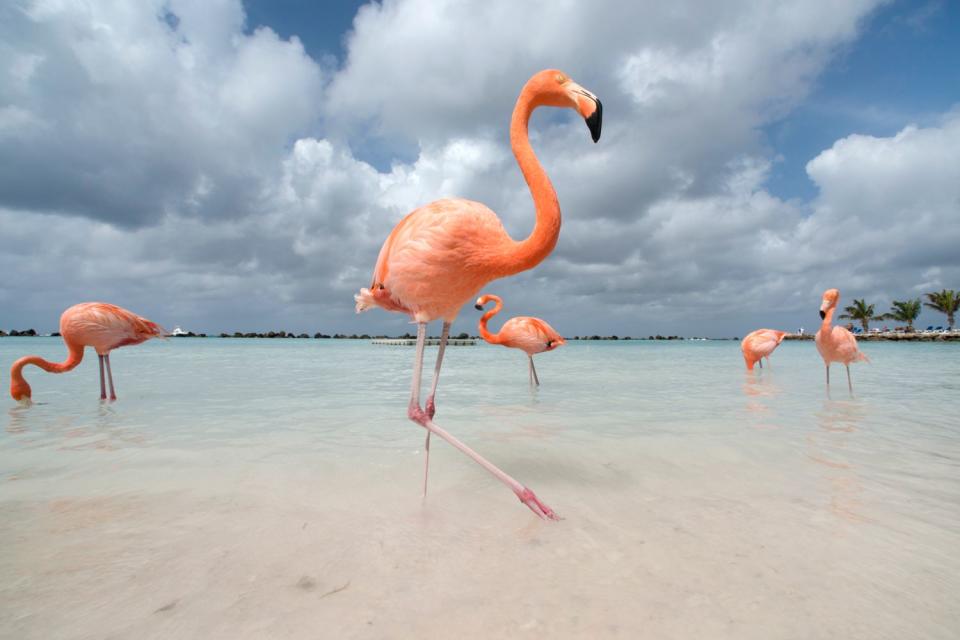Wild Flamingos Spotted in Landlocked States and Other Surprising Places After Hurricane Idalia
Parts of the country have witnessed rare sightings of the bird following last week's storm

Getty
Flamingos have been spotted in unlikely parts of the country after Hurricane Idalia.In the aftermath of Hurricane Idalia, it wasn’t phoenixes who rose above the ashes but rather wild flamingos.
Various parts of the country, including the East Coast, have experienced rare flamingo sightings attributed to last week’s major storm that hit Florida.
Per USA Today, the iconic birds first appeared all over Florida as the storm crossed over. Jeff Bouton of Kowa Sporting Optics told the outlet that over 70 flamingos were reported in the Sunshine State.
Vinnie Fugett told WFTS Tampa Bay that he saw flamingos on Treasure Island Beach for the first time. “I was completely shocked after living here for 35 years, my entire life, and being a Florida native. I've never seen flamingos in the area," Fugett said.
Related: Flamingo Returns to Oklahoma City Zoo Flock with New Leg Brace After 4 Months at Animal Hospital
Fugett added, “You think of flamingos when you think of Florida, but traditionally, you don't actually see them walking up and down the beach unless you go to Busch Gardens or Sunken Gardens."
According to the Florida Fish and Wildlife Conservation Commission, about 95 percent of flamingo sightings in Florida occur in the Everglades, Biscayne Bay, and the Florida Keys.
Flamingos are distinguished by their pink-colored plumage and black flight feathers on their wings, according to the Smithsonian’s National Zoo. Common in the Caribbean Islands and South America’s northern coast, some flamingo flocks can total in the thousands. The life span of the American flamingo, the largest of the species, is approximately 40-60 years.
Experts say Idalia was responsible for redirecting the flamingos’ normal flight patterns. “These birds are most likely just blown off course, while they were traveling maybe from the Yucatan to Cuba or the Bahamas,” Hannah McDougall of the Pelican Harbor Seabird Station told WAVY.
Never miss a story — sign up for PEOPLE's free daily newsletter to stay up-to-date on the best of what PEOPLE has to offer, from celebrity news to compelling human interest stories.
Keith Laakkonen, director of Corkscrew Swamp Sanctuary near Naples, shared a theory similar to that of McDougall’s about how this happened, per News-Press. “They’ve been seen at three different places today, the Sanibel Causeway, in Punta Gorda and Tarpon Springs," he said.
Jerry Lorenz, state director of research for Audubon Florida, told USA Today that the flamingos “came in on the storm, whether they wanted to or not."
And it’s just not Florida: flamingos have also been reportedly seen recently in Alabama, North Carolina, South Carolina, Ohio, Tennessee, Texas, and Virginia, per WAVY.
Jeff Lewis spotted several flamingos from an observation tower in Pea Island National Wildlife Refuge in North Carolina this past Saturday. The rare sighting left him excited. “There were some pink birds way out there and I thought, ‘Oh my God,’ my heart started thumping,” he told Audubon North Carolina, adding: “It was heart-stopping. My fingers were hitting all the wrong keys on my phone.”
In Ohio, officers said that people have been visiting Caesar Creek Lake to take pictures following news of flamingos arriving there, per WLWT.
As for the flamingos' future, Lorenz told USA Today that they could return to their original destinations while adding that he hopes they stay in Florida to restart a new breeding population.
Nathan Dias, an ornithologist and resident of Charleston, South Carolina, told the Post and Courier that he is not concerned about flamingos’ ability to survive in the Palmetto State amid reports that they were spotted on Bulls Island. He expressed hope that the flamingos would find refuge in salt marshes prior to them heading over to Florida, per the newspaper.
For more People news, make sure to sign up for our newsletter!
Read the original article on People.

 Yahoo News
Yahoo News 
